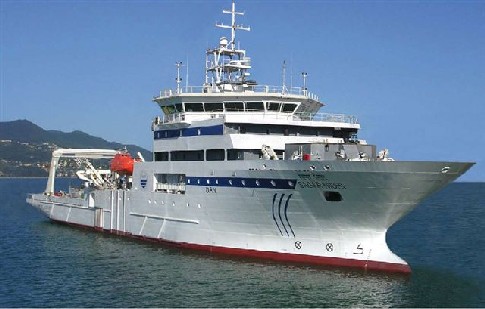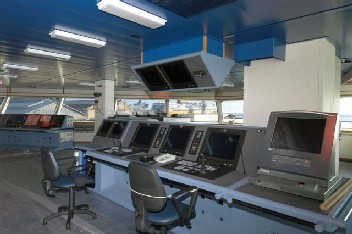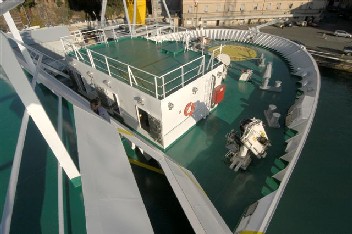A hi-tech ship with state-of-the-art technology and research gear all packed into one, is the Sagar Nidhi. Owned by the Chennai-based National Institute of Ocean Technology (NIOT), this ship was custom-made by an Italian shipyard.
 On a cloudy Sunday evening 3rd Aug 2008, I visited this ship at Chennai harbour on a special permission along with my parents and friends. Mr D. Rajasekhar, Head, Vessel Management Group, NIOT, explained all the features of the ship. “She (yes, that’s how a ship is addressed!) is an ice-class ship. That is, she can cut through ice and sail in places like Antarctica where people are headed soon for research”, he said.
On a cloudy Sunday evening 3rd Aug 2008, I visited this ship at Chennai harbour on a special permission along with my parents and friends. Mr D. Rajasekhar, Head, Vessel Management Group, NIOT, explained all the features of the ship. “She (yes, that’s how a ship is addressed!) is an ice-class ship. That is, she can cut through ice and sail in places like Antarctica where people are headed soon for research”, he said.
Fascinated, I eagerly pressed on for more. Tsunami monitors were deployed in the South Andaman last week, he informed. I saw lots of ‘stuff’ being loaded onto the deck using the A-Frame, which is the hydraulic crane on the deck. The ship was leaving by ‘early tide’ in the morning to deploy ‘data buoys’ in the Indian Ocean. Wo..oow, please hold on!
 Totally clueless, I asked him to make it simple. So here goes:
Totally clueless, I asked him to make it simple. So here goes:
Sagar Nidhi is a 5000 tonne vessel with a ship’s crew of 55 consisting of a Captain, Engineer, Doctor, Navigator and other technical, logistics and administrative / maintenance staff. The research teams from NIOT or any other institute will be headed by a Chief Scientist and the size of the assisting technical team would be according to the job-at-hand. She is one of its kinds in Asia.
She has an endurance of 45 days, that is, technically and supplies-wise it can be at sea for 45 days at a stretch. In ship’s terminology, port means left and starboard means right, aft and astern are north and south when you are looking at the forward part of the ship. She has a total of 5 decks comprising of the bridge, also known as the wheelhouse, research labs, conference hall, cabins, galley (meaning kitchen), cold storage unit, gym-sauna, recreation centre, dining rooms, etc
 The ship is capable of deploying:
The ship is capable of deploying:
1. Remotely Operated Vehicles (ROV): It’s a robot sent into the sea for various ocean research activities to a depth of 6000 metres.
2. Manned Submersibles: It’s a pressure vessel with robotic arrangements, will be sent into sea for underwater monitoring till a depth of 6000mts.
3. Tsunami monitoring systems: Bottom Pressure Recorders (BPR) are positioned on seabed for transmitting tsunami alerts.
Data buoys are buoyant spheres equipped with sophisticated instruments that are deployed at various points in the Indian Ocean. These buoys once in place will transmit important information through satellite about currents, waves, temperatures, etc which will be received at NIOT’s communication centre. This will be monitored and made use of in predicting weather, climate and tsunami-alerts. Sagar Nidhi is also being used for extracting deep-sea fuel in the form of gas hydrates.
Phew! That was a very exhaustive visit yet very thrilling. I intend pursuing the research that they will be doing and keep you all posted as and when it happens. For any visit to the ship, one may contact rajasekhar@niot.res.in
